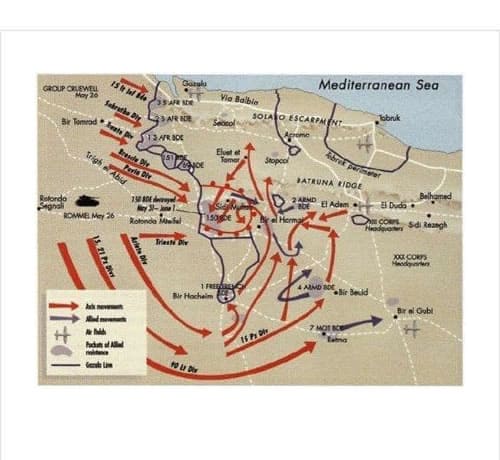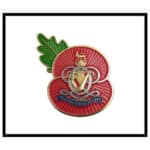Meanwhile ‘B’ Echelon commanded by Captain Earle was also having difficulties.
At 7.15 on that same morning of May 27th, armoured cars reported that two columns of the enemy were some three miles away. one passing north and one east. At 8 a.m. the Echelon moved east, with many stops and starts owing to other transport. However, at 9 a.m. they were approached by a small car with an English-speaking officer of unknown identity inside it. He told Earle to halt and proceed southeast, which he refused to do, but on discovering that the officer was a German he halted the Echelon. Captain Earle wrote later:
“I was then told to dismount and, together with the Quarter-Master, Lieutenant Hedley, “Was made to put my hands up. By this time armoured cars and an anti-tank trailer-drawn gun were around the front of us. We managed to get rid of all codes by burning and burying them, and also to send through by wireless to Brigade ‘B’ Echelon Headquarters our position, circumstances and the strength of the enemy.
“Meantime Lieutenants Walker, Lockhart and Captain Alcock R.A.O.C. came up to the head of the column to see what was the matter, not realising the position, and were made to put up their hands. Walker and Lockhart managed to wander off as the opportunity occurred jumped on to a 15 cwt. and headed north.
They were headed off by German armoured cars and forced south, but by making their way through gaps eventually got away south-east, although they covered some ten miles before getting clear. Two days later they made their way back to ‘B’ Echelon west of el Adem, collecting two stray ‘B’ Squadron vehicles on the way.
“Scott in the meantime quickly summed up the position and moved off southeast with all his vehicles. He managed to get clean away and via Bir Berraneb and Capuzzo returned to the Echelon four days later east of el Adem. His action and judgement were creditable.
Ladenburg’s action is best described in his own account to me and will follow.
“The enemy meanwhile had taken over all the vehicles nearby and made the drivers, etc. prisoners. They put their own men on the lorries and drove them off southeast to join their main column, which was now appearing. Hedley, Alcock. and all the prisoners were also dispatched.
“While all this was going on a 15 cwt. driven by an Indian pulled up. In it were a wounded British officer and an Indian officer. I got permission to attend to the British officer and in so doing missed being included in the party containing the prisoners and captured vehicles, which had been sent to join the German columns. When we did finally join them we found that all the other prisoners had been sent back. Our party was therefore forced to accompany the columns. I myself was placed in a staff car with two German officers.
I estimated that the German column consisted of some 2,000 vehicles, all told. We went east as far as Bir el Gubi and then turned north and proceeded to the first escarpment between Sidi Rezegh and al Adem. Opposition was negligible and our speed of progress unbelievably swift. The head of the column consisted of a mass of guns of all sorts, together with lorried infantry.
“The escarpment was reached at about 4 p.m. Below us lay several hundred British vehicles completely unaware of our existence. Fortunately, the Germans opened fire from the top and gave enough warning for a very large number to get away. Had they gone quietly down I am sure they could have captured practically the lot.
At the bottom of the escarpment, we came across a badly wounded British officer. I was given permission to attend to him and in so doing got away from my escort who went on ahead.
“At about 6 p.m. I came on some more prisoners and joined up with them, and half an hour later we were shelled by 25-pounders for ten minutes or so. At 7.30 p.m. the shelling started in earnest and the Germans withdrew their softer stuff up the escarpment again. The shelling became very heavy and a lot of men and a few officer prisoners made off with the enemy.
About twelve officers and a hundred men remained, and for two hours we lay low while the battle raged. Fortunately, we had few casualties. British tanks joined in at about 10. 15 p.m. and added to our misery by firing at us, with their 37-mm. and machine-guns.
“The Germans made three attempts to make us fall back to their lines. but they had the wind up pretty well and disliked standing up and arguing with us. Eventually, they all withdrew up the escarpment as darkness fell, leaving us behind. When it was quite dark we set off north-west towards Tobruk. but after a couple of miles ran into the 4th Armoured Brigade, moving cast.
The following morning I rejoined the unit and then Brigade ‘B’ Echelon when during the next few days more than fifty per cent of our vehicles were collected together.
“Until the Regiment was withdrawn no further untoward events took place over than the usual fortunes of war such as bombing, machine-gunning and so on. Supplies became disorganised and on one day we spent thirteen hours obtaining rations from the R.A.S.C. The average time spent in getting up to the Regiment from leaguer was five hours.”
Lieutenant Ladenburg, who had been at the other end of ‘B’ Echelon column that morning saw the Germans capture Earle and Hedley. He wrote:
“As it seemed impossible to open fire on the Germans for fear of killing you and Charlie, I ran over to Sergeant Garrod and told him to lead his line of vehicles after me, as we were going to try and make a break for it.
On returning to my own vehicle which was less than a hundred yards away and was alongside the S.Q.M.S.’s 3-tonner, I noticed Garrod already being taken prisoner so I shouted to Newman to get moving and follow me. I shouted the same thing to several vehicles on my way through the halted column but as I had no driver I could not see whether they had got their lorries moving or not.
“Having drawn off about a mile I stopped and found there were only three vehicles following me. As there didn’t seem to be much activity in the halted column and I could still see the main crowd gathered around you and Charlie I returned to the scene, picked up a few men who had already had their lorries taken away from them and, with the encouraging aid of their shouts this time I was able to draw out of the column almost the complete L.A.D. and a few other vehicles. When I reached the other three who were still waiting for me (or perhaps they had already moved off on their own, I really cannot remember now) we were about twenty-five vehicles in all.
“As Sergeant-Major Patman had much the fastest car I told him to get ahead in a north-easterly direction to act as a scout, and the rest of us followed on. After going about a mile Patman stopped and we followed suit. I found we were being fired on by small arms. The majority of the men went to ground and just then a Royal Artillery officer came up with us.
We decided between us the best direction to move on, having regard to the fact that about a regiment of enemy tanks was approaching from the south, about two miles away, and that the small arms fire had apparently come from two or three armoured cars to our north-west – I don’t know whether these were enemy or our own.
As the Artillery officer and myself started to move I shouted to Patman to follow on. After going less than a mile I told the man on my left to make sure the other vehicles were following me. To my amazement, he said they were far behind and going far more south than us, in other words, they were heading straight for the enemy tanks.
It only remains to say that we got through and they did not and I have no reason to offer why Patman failed to follow us. By then it was too late to try and chase after him again.”
The thin skins, under command of Lieutenant Robertson and S.S.M. Spooner, succeeded in getting away intact from the morning’s hold-up, which was, in the circumstances, a creditable performance. They withdrew north-east and joined Brigade ‘B’ Echelon at Blr el Chelb, and then went east with them to Abiar el Mgaier where they were joined by what was left of Regimental Headquarters and various personnel from the Sabre Squadrons.
Captain Wagstaffe took over the Adjutancy on this day.
Related topics
- A short history of The 8th Hussars
- Middle East (Egypt and Libya) timeline
- Article: The Battle of Bir Hacheim, May 1942 – The Regiment
- Article: The Battle of Bir Hacheim, May 1942 – ‘B’ Echelon
- Article: The Battle of Bir Hacheim, May 1942 – Escape Stories
- Article: The Battle of Bir Hacheim, May 1942 – ‘C’ Squadron with 3 RTR



